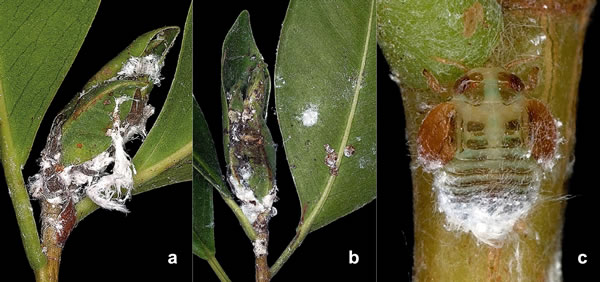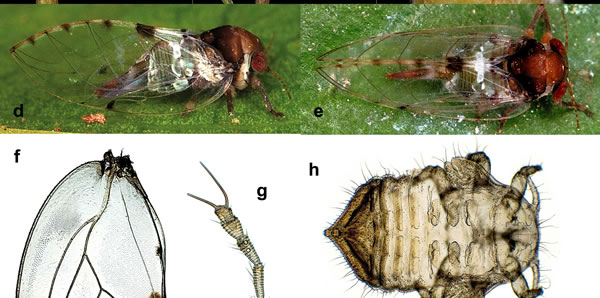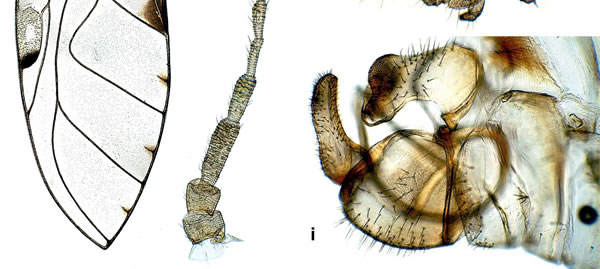
Macrohomotoma gladiata Kuwayama, 1908: a jumping plant-lice recently introduced into the EPPO Region (Hemiptera: Psylloidea)
David Mifsud* & Francesco Porcelli** (2012)
* University of Malta, Junior College, Department of Biology, Msida MSD 1252, Malta.
** Università degli Studi di Bari Aldo Moro, DiBCA Sez. Entomologia e Zoologia, Bari, Italy.
The presence of an unusual psyllid was observed infesting a few twigs of eight amenity fig trees (Ficus microcarpa) in the Campus of the University of Alicante (Spain) on July the 20th, 2011. The species was identified as Macrohomotoma gladiata (Hemiptera: Homotomidae), a species of Asian origin. Because M. gladiata is considered to be a pest of F. microcarpa in its area of origin, the authors considered it useful to provide this report and pictures to facilitate its identification.
Short description
Body length from 2-3 mm. General body coloration light to dirty brown. Genae yellowish brown. Antennae 10-segmented, yellow-brown with last segment black. Forewings transparent, with dark markings proximal of Cu1a and mainly at apex of pterostigma. Head as wide as thorax, strongly arched downwards. Vertex about 2.5 times as wide as long. Genae small, swollen beneath antennal sockets. Thorax strongly arched. Forewing about 2.4 times as long as wide. Metatibia without basal spines, with 4 apical inner spurs. Aedeagus long, basal segment 2 times as long as apical.
Host plants
M. gladiata is an oliphagous species which has only been recorded on Ficus microcarpa (syn. F. retusa) (Moraceae).
Taxonomic placement
The genus Macrohomotoma currently accommodates 14 described species which are distributed from India to Australia (Northern Queensland) (Hollis & Broomfield, 1989).
World distribution
M. gladiata is known to occur in the following Asian countries: Ryukyu Islands (Japan), Sumatra (Indonesia), and Taiwan. This is the first time that a species belonging to the family Homotomidae is being recorded outside its native range, and the authors have informed the NPPO of Spain of this finding.
Symptoms on infested host plant
Infestations can easily be detected because of the relatively large amount of white and woolly waxy secretions that are produced by the nymphs. Additional symptoms are the presence of rolled leaves at the tip of the twigs. M. gladiata has the potential to damage F. microcarpa trees that have been planted for amenity purposes in the EPPO region. On the basis of this isolated observation, the authors could not confirm the possible establishment of the species.
Literature
Hollis D & Broomfield PS (1989) Ficus-feeding psyllids (Homoptera), with special reference to the Homotomidae. Bulletin of the British Museum (Natural History) (Entomology) 58(2), 131-183.



Macrohomotoma gladiata: a & b) tip of infested fig twigs; c) nymph dispersing before last molt; d & e) adult female, side and dorsal view; f) left forewing; g) adult male antenna; h) slide-mounted first nymph; i) adult male terminalia.
